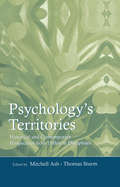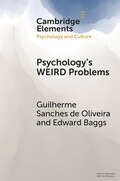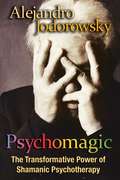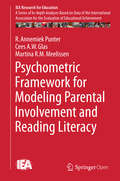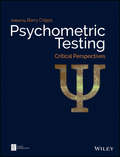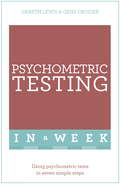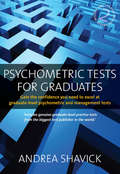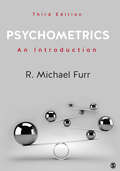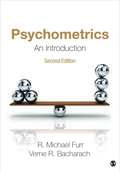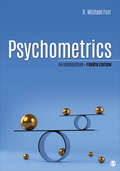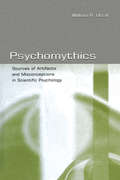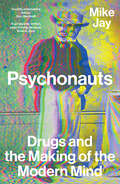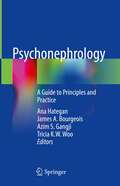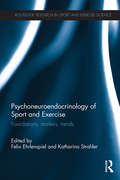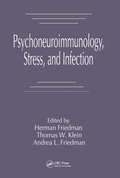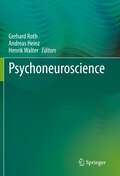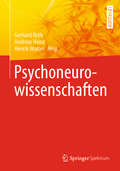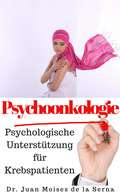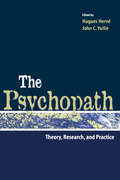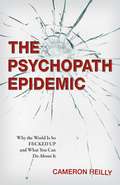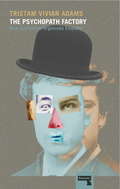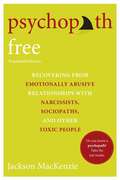- Table View
- List View
Psychology's Territories: Historical and Contemporary Perspectives From Different Disciplines
by Thomas Sturm Mitchell AshWhat are the conceptual and practical territories of psychology? How have the boundaries of psychological thought, research and practice developed in history, and how might they be renegotiated today? This volume presents new approaches to these questions, resulting from a three-year collaboration among internationally known psychologists, neurosci
Psychology's WEIRD Problems (Elements in Psychology and Culture)
by Guilherme Sanches de Oliveira Edward BaggsPsychology has a WEIRD problem. It is overly reliant on participants from Western, Educated, Industrialized, Rich, and Democratic societies. Over the last decade this problem has come to be widely acknowledged, yet there has been little progress toward making psychology more diverse. This Element proposes that the lack of progress can be explained by the fact that the original WEIRD critique was too narrow in scope. Rather than a single problem of a lack of diversity among research participants, there are at least four overlapping problems. Psychology is WEIRD not only in terms of who makes up its participant pool, but also in terms of its theoretical commitments, methodological assumptions, and institutional structures. Psychology as currently constituted is a fundamentally WEIRD enterprise. Coming to terms with this is necessary if we wish to make psychology relevant for all humanity. This title is also available as Open Access on Cambridge Core.
Psychomagic: The Transformative Power of Shamanic Psychotherapy
by Alejandro JodorowskyA healing path using the power of dreams, theater, poetry, and shamanism • Shows how psychological realizations can cause true transformation when manifested by concrete poetic acts • Includes many examples of the surreal but successful actions Jodorowsky has prescribed to those seeking his help While living in Mexico, Alejandro Jodorowsky became familiar with the colorful and effective cures provided by folk healers. He realized that it is easier for the unconscious to understand the language of dreams than that of rationality. Illness can even be seen as a physical dream that reveals unresolved emotional and psychological problems. Psychomagic presents the shamanic and genealogical principles Jodorowsky discovered to create a healing therapy that could use the powers of dreams, art, and theater to empower individuals to heal wounds that in some cases had traveled through generations. The concrete and often surreal poetic actions Jodorowsky employs are part of an elaborate strategy intended to break apart the dysfunctional persona with whom the patient identifies in order to connect with a deeper self. That is when true transformation can manifest. For a young man who complained that he lived only in his head and was unable to grab hold of reality and advance toward the financial autonomy he desired, Jodorowsky gave the prescription to paste two gold coins to the soles of his shoes so that all day he would be walking on gold. A judge whose vanity was ruling his every move was given the task of dressing like a tramp and begging outside one of the fashionable restaurants he loved to frequent while pulling glass doll eyes out of his pockets. The lesson for him was that if a tramp can fill his pockets with eyeballs, then they must be of no value, and thus the eyes of others should have no bearing on who you are and what you do. Taking his patients directly at their words, Jodorowsky takes the same elements associated with a negative emotional charge and recasts them in an action that will make them positive and enable them to pay the psychological debts hindering their lives.
Psychometric Framework for Modeling Parental Involvement and Reading Literacy
by Annemiek Punter Cees A. W. Glas Martina R. M. MeelissenThis volume offers insights from modelling measures of parental involvement and their relationship with student reading literacy across countries, exploring and incorporating cultural differences. This is a significant contribution to a field where cross-cultural comparisons from a triangulated perspective are sparse. For readers interested in exploring the relationship between parental involvement and student attainment, the literature review provides a useful starting point. Meanwhile, for the more methodologically interested reader, this report presents state-of-the-art ways to identify and model cultural differential item functioning in international large-scale assessment (ILSA), illustrating the extent to which the parental involvement construct may be influenced by cultural differences and how this may affect the outcomes of cross-cultural comparisons. The framework is generic and should provide a solid foundation for future ILSA practices and secondary analyses. ILSA studies like the IEA's Progress in International Reading Literacy Study (PIRLS) provide valuable data, containing both student achievement data and contextual background data from schools, teachers, students and parents for over 41 countries.
Psychometric Testing: Critical Perspectives (BPS Textbooks in Psychology)
by Barry CrippsPsychometric Testing offers an in-depth examination of the strengths and limitations psychometric testing, with coverage of diverse methods of test development and application. A state-of-the-art exploration of the contemporary field of psychometric testing, bringing together the latest theory and evidence-based practice from 21 global experts Explores a variety of topics related to the field, including test construction, use and applications in human resources and training, assessment and verification of training courses, and consulting Includes applications for clinical psychology, performance psychology, and sport and exercise psychology across a range of professions (research, teaching, coaching, consulting, and advising) Acknowledges the dynamic nature of the field and identifies future directions in need of more research, including Internet and smart phone testing
Psychometric Testing In A Week: Using Psychometric Tests In Seven Simple Steps (Teach Yourself In A Week Ser.)
by Gareth Lewis Dr Gene CrozierPsychometric testing just got easierWe can measure how tall someone is, how strong they are or how fast they can run. But is it also possible to evaluate an individual's character traits, how they think and how they mightreact in a given situation? With psychometric tests, we can.Most people feel some trepidation at just the thought of taking a psychometric test. These tests can also be a source of anxiety for those who have never administered them before. If you are a project manager or an HR professional tasked with introducing psychometric tests to your organization and have no previous experience of using them, then reading this book is the first step you should take. Our aim is to overcome any fear of using tests by demystifying a subject that can, for the uninitiated, seem quite complex and daunting. This not a technical manual and so we have avoided unnecessary jargon and academic language. You certainly won't need a degree in mathematics or psychology to comprehend any of the contents. We will provide simple descriptions of psychometric tests, the benefits they offer, and the practical measures you will need to take to use them effectively. In just seven days, you will gain a basic understanding of psychometric tests that will serve as a sound foundation for whatever further learning you decide to pursue.Each of the seven chapters in Psychometric Testing In A Week covers a different aspect:- Sunday: The importance of psychometric testing- Monday: What are psychometric tests?- Tuesday: Tests of ability and aptitude- Wednesday: What is personality?- Thursday: Selecting psychometric tests- Friday: The uses of psychometric tests- Saturday: The organizational perspective
Psychometric Testing In A Week: Using Psychometric Tests In Seven Simple Steps (Teach Yourself In A Week Ser.)
by Gareth Lewis Gene CrozierThe ability to understand and perform well in psychometric tests is crucial to anyone who wants to advance their career.Written by Gareth Lewis and Gene Crozier, leading experts on psychometric testing, this book quickly teaches you the insider secrets you need to know to in order to make psychometric tests work for you.The highly motivational 'in a week' structure of the book provides seven straightforward chapters explaining the key points, and at the end there are optional questions to ensure you have taken it all in. There are also cartoons and diagrams throughout, to help make this book a more enjoyable and effective learning experience.So what are you waiting for? Let this book put you on the fast track to success!
Psychometric Tests for Graduates: Gain the confidence you need to excel at graduate-level psychometric and management tests
by Andrea ShavickAre you a graduate? Looking for a brilliant job? Then you should know that over 95 percent of the FTSE 100 companies use psychometric and management tests to select their graduate recruits, as do the police, the Civil Service, local authorities, the Armed Forces, the Fire Service, financial institutions, the motor industry, the IT industry - the list is endless. In fact, tests are now an integral part of the recruitment process for most medium-large sized organisations worldwide. So if you're looking for a job, you need this book! It includes: 37 genuine graduate-level practice tests from SHL Group plc, the biggest test publisher in the world; 227 questions covering verbal, numerical, abstract and spatial reasoning, mechanical comprehension, fault diagnosis, accuracy and personality; and, genuine practice Brainstorm, Scenarios and Fastrack management tests. It also includes valuable advice on: online psychometric tests; researching your target employer; and, assessment centre visits (including role-plays, group discussions, in-tray exercises and presentations). This book gives you the three things you need to pass graduate-level psychometric and management tests: information, confidence, and plenty of practice.
Psychometrics: An Introduction (Sage Library In Social And Personality Psychology Methods Ser.)
by R. Michael FurrUsing a meaning-based approach that emphasizes the “why” over the “how to,” Psychometrics: An Introduction provides thorough coverage of fundamental issues in psychological measurement. Author R. Michael Furr discusses traditional psychometric perspectives and issues including reliability, validity, dimensionality, test bias, and response bias as well as advanced procedures and perspectives including item response theory and generalizability theory. The substantially updated Third Edition includes broader and more in-depth coverage with new references, a glossary summarizing over 200 key terms, and expanded suggested readings consisting of highly relevant papers to enhance the book’s overall accessibility, scope, and usability.
Psychometrics: An Introduction (Sage Library In Social And Personality Psychology Methods Ser.)
by R. Michael FurrUsing a meaning-based approach that emphasizes the “why” over the “how to,” Psychometrics: An Introduction provides thorough coverage of fundamental issues in psychological measurement. Author R. Michael Furr discusses traditional psychometric perspectives and issues including reliability, validity, dimensionality, test bias, and response bias as well as advanced procedures and perspectives including item response theory and generalizability theory. The substantially updated Third Edition includes broader and more in-depth coverage with new references, a glossary summarizing over 200 key terms, and expanded suggested readings consisting of highly relevant papers to enhance the book’s overall accessibility, scope, and usability.
Psychometrics: An Introduction
by R. Michael Furr Dr Verne R. BacharachFrom a perspective that focuses on the meaning, purpose, and implications of key psychometric concepts, principles, and procedures, Psychometrics: An Introduction, Second Edition (by R. Michael Furr and Verne R. Bacharach) introduces the subject and study of psychometrics. It addresses these topics at a level that is deeper and more focused than what is found in typical introductory undergraduate testing and measurement texts, but is much more intuitive than what is traditionally found in the more technical publications intended for advanced graduate courses. By emphasizing concepts over mathematical proofs and by focusing on practical significance, this book assists students in appreciating not just how measurement problems can be addressed, but why it is crucial to address them.
Psychometrics: An Introduction
by Richard Michael FurrIn this fully revised Fourth Edition of Psychometrics: An Introduction, author R. Michael Furr centers his presentation around a conceptual understanding of psychometric core issues, such as scales, reliability, and validity. Focusing on purpose rather than procedure and the "why" rather than the "how to," this accessible book uses a wide variety of examples from behavioral science research so readers can see the importance of psychometric fundamentals in research. By emphasizing concepts, logic, and practical applications over mathematical proofs, this book gives students an appreciation of how measurement problems can be addressed and why it is important to address them. The book offers readers the most contemporary views of topics in psychometrics available in the nontechnical psychometric literature.
Psychometrics: An Introduction
by Richard Michael FurrIn this fully revised Fourth Edition of Psychometrics: An Introduction, author R. Michael Furr centers his presentation around a conceptual understanding of psychometric core issues, such as scales, reliability, and validity. Focusing on purpose rather than procedure and the "why" rather than the "how to," this accessible book uses a wide variety of examples from behavioral science research so readers can see the importance of psychometric fundamentals in research. By emphasizing concepts, logic, and practical applications over mathematical proofs, this book gives students an appreciation of how measurement problems can be addressed and why it is important to address them. The book offers readers the most contemporary views of topics in psychometrics available in the nontechnical psychometric literature.
Psychomythics: Sources of Artifacts and Misconceptions in Scientific Psychology
by William R. UttalPsychology deals with the most complex subject matter of any science. As such, it is subject to misunderstandings, artifacts, and just simple errors of data, logic, and interpretation. This book teases out the details of some of the sources of these errors. It considers errors in psychological data and theories that arise from confusing endogenous and exogenous causal forces in perceptual research, misinterpreting the effects of inevitable natural laws as psychological phenomena, improper application of statistics and measurement, and flawed assumptions. Examples of each of these sources of error are presented and discussed. Finally, the book concludes that a return to a revitalized kind of behaviorism is preferred, rather than continuing on the current cognitive path.
Psychonauts: Drugs and the Making of the Modern Mind
by Mike JayA provocative and original history of the scientists and writers, artists and philosophers who took drugs to explore the hidden regions of the mind &“Captivating. . . . A welcome reconsideration of the role drugs play in life, medicine, and science.&”—Publishers Weekly Until the twentieth century, scientists investigating the effects of drugs on the mind did so by experimenting on themselves. Vivid descriptions of drug experiences sparked insights across the mind sciences, pharmacology, medicine, and philosophy. Accounts in journals and literary fiction inspired a fascinated public to make their own experiments—in scientific demonstrations, on exotic travels, at literary salons, and in occult rituals. But after 1900 drugs were increasingly viewed as a social problem, and the long tradition of self-experimentation began to disappear. From Sigmund Freud&’s experiments with cocaine to William James&’s epiphany on nitrous oxide, Mike Jay brilliantly recovers a lost intellectual tradition of drug-taking that fed the birth of psychology, the discovery of the unconscious, and the emergence of modernism. Today, as we embrace novel cognitive enhancers and psychedelics, the experiments of the original psychonauts reveal the deep influence of mind-altering drugs on Western science, philosophy, and culture.
Psychonephrology: A Guide to Principles and Practice
by James A. Bourgeois Ana Hategan Azim S. Gangji Tricia K. W. WooThe book focuses on pharmacological and non-pharmacological approaches of psychiatric syndromes that commonly occur in patients with kidney disease. It specifically reviews principles of psychotherapy and psychopharmacology with an emphasis on organ impairment and drug-drug interactions specific to nephrology. This book also covers issues with medication nonadherence in patients with chronic kidney disease and psychiatric comorbidity, as well as the associated issues in dialysis and renal transplantation. Additionally, chapters cover various other topics addressing an active stance towards health promotion in chronically ill patients, including the critical role of the diet and physical activity. Such advice is often complex and changing depending on the stage of chronic kidney disease and the individual needs of the patient. Written by specialists in the field, Psychonephrology: A Guide to Principles and Practice serves as a valuable reference and teaching tool that provides an opportunity for learning across a rapidly evolving medical field.
Psychoneuroendocrinology of Sport and Exercise: Foundations, Markers, Trends (Routledge Research in Sport and Exercise Science)
by Felix Ehrlenspiel Katharina StrahlerPsychoneuroendocrinology is the study of the interaction between hormones, the brain and human behaviour. This is the first book to examine psychoneuroendocrinology in the context of sport and exercise, offering a comprehensive review of current research and assessment techniques and highlighting directions for future research. The book explores the links between hormones and behaviour, and draws important conclusions for how their study will aid in the understanding of the bidirectional link between sport and behaviour, central to the psychology of sport and exercise. It presents the key hormones that underpin behaviour in a sporting context, including the description of their physiologic mechanisms and behavioural effects. The book reports benchmark standards for the assessment and analysis of hormonal influences of behaviour in sport, and examines practical issues and contexts such as emotional state, overtraining and stress. Psychoneuroendocrinology in Sport and Exercise is a breakthrough text that will be of interest to all advanced students and researchers working in the psychology and physiology of sport and exercise.
Psychoneuroimmunology, Stress, and Infection
by Herman Friedman Thomas W. Klein Andrea L. FriedmanPsychoneuroimmunology is the emerging science devoted to studying the two-way relationship between the nervous and immune systems. Psychoneuroimmunology, Stress, and Infection highlights the latest information concerning microbial infections in both man and animals as related to stress and especially stress hormones.The volume focuses on psychoneuroimmunology as it impacts the immune system in general and also the relationship between neurological events which influence susceptibility and/or resistance to infectious agents such as bacteria, fungi and viruses, as well as parasites. Prominent researchers describe the involvement of the hypothalamus-pituitary-adrenal (HPA) axis on immunity as a function of the nervous system. The text discusses hormones such as prolactin and growth hormone and steroid induced susceptibility to infection and neuropeptides, including vasoactive intestinal peptide, and substance P. The effects of catacholamines on immunity and susceptibility to infection are also covered. This reference also details the involvement of immune cells in the synthesis of neuropeptides, including hormones and endorphins, their effect on the brain as well as the effects of interleukins and tumor necrosis factor on the central nervous system. The book concludes with an interesting look at the relationship between aging, psychoneuroimmunology, and infection. Although there is much new knowledge concerning the nature and mechanism of immune responses, including the mediators involved, Psychoneuroimmunology, Stress, and Infection also presents important discussions and reviews that are long overdue and provide a major contribution to the area of biomedical knowledge in general and psychoneuroimmunology in particular.
Psychoneuroscience
by Martin LayThe textbook builds a bridge between the "neurosciences" (theoretical and experimental neurobiology, neurology) and the "psychosciences" (psychology, psychiatry, psychotherapy) and aims to help provide the other disciplines with the most important and scientifically validated knowledge in an understandable form. The question of how mental experience and brain processes relate to each other has long been considered mysterious. In this book you will learn, based on the latest scientific findings, that the two areas form an indissoluble unity, even if we experience and study them differently. We present this unity in concrete terms in psychological-neurobiological theory and psychiatric-psychotherapeutic practice. We treat the principles of neurobiological excitation and information processing, the structure and function of the limbic system, the development of the personality and the interaction of genetic-epigenetic factors and prenatal and postnatal environmental influences, which may be favourable or unfavourable. On this basis, the exemplary presentation of important mental disorders such as addictive disorders, schizophrenic disorders, affective disorders and anxiety disorders takes place. Finally, following in the footsteps of the eminent psychotherapist Klaus Grawe, the concept of "neuropsychotherapy" is introduced and it is shown why psychotherapy and neurobiology belong together and can enrich each other. Our psychoneuroscientific approach paints a picture of man that is not based on opposites, but on an integration of psyche, brain, behavior and experience.
Psychoneurowissenschaften
by Martin LayDas Lehrbuch schlägt eine Brücke zwischen den „Neurowissenschaften“ (theoretische und experimentelle Neurobiologie, Neurologie) und den „Psychowissenschaften“ (Psychologie, Psychiatrie, Psychotherapie) und will dabei helfen, den jeweils anderen Disziplinen die wichtigsten und wissenschaftlich gesicherten Kenntnisse in verständlicher Form zu liefern. Die Frage, wie sich psychisches Erleben und Gehirnvorgänge zueinander verhalten, galt lange als rätselhaft. In diesem Buch erfahren Sie aufgrund neuester wissenschaftlicher Erkenntnisse, dass beide Bereiche eine unauflösliche Einheit bilden, auch wenn wir sie unterschiedlich erfahren und untersuchen. Diese Einheit stellen wir in der psychologisch-neurobiologischen Theorie und der psychiatrisch-psychotherapeutischen Praxis konkret dar. Wir behandeln die Prinzipien der neurobiologischen Erregungs- und Informationsverarbeitung, Aufbau und Funktion des limbischen Systems, die Entwicklung der Persönlichkeit und der dabei stattfindenden günstig oder ungünstig verlaufenden Interaktion genetisch-epigenetischer Faktoren und vorgeburtlich sowie nachgeburtlich stattfindender Umwelteinflüssen. Auf dieser Grundlage erfolgt die beispielhafte Darstellung wichtiger psychischer Störungen wie Suchterkrankungen, schizophrene Störungen, affektive Störungen sowie Angststörungen. In der Nachfolge des bedeutenden Psychotherapeuten Klaus Grawe wird schließlich in das, Konzept der „Neuropsychotherapie“ eingeführt und gezeigt, warum Psychotherapie und Neurobiologie zusammengehören, und sich gegenseitig bereichern können. Unser psychoneurowissenschaftlicher Ansatz zeichnet ein Menschenbild, das nicht auf Gegensätzen, sondern einer Integration von Psyche, Gehirn, Verhalten und Erleben beruht.
PsychoOnkologie
by Juan Moises de la Serna Cristina De SousaIn diesem E-Buch wird das Problem der Krebserkrankung aus psychologischer Sicht nähert, dessen Bereich der Studie ist in Psychoonkologie angegeben. Zu diesem Zweck wird die neueste Forschung im Zusammenhang mit diesem Bereich angeboten, so dass der Patient und seine / ihre Verwandten wissen können, die neuesten, die in Bezug auf die psychologischen Aspekte des Aussehens, der Erhaltung und Behandlung von Krebs entdeckt wurde. Eine Beratung E-Buch, das die Krankheit, die eine der am häufigsten heute geworden ist, zu relativieren helfen kann
The Psychopath: Theory, Research, and Practice
by Hugues Hervé John C. YuilleThe Psychopath: Theory, Research, and Practice is a comprehensive review of the latest advancements in the study of psychopathy. As research into psychopathy over the past two decades has burgeoned, it has had significant implications for clinical practice, with important ethical considerations raised as interest into psychopathy has moved into the real world. This volume is the first comprehensive review of these applied topics. Dr. Robert Hare, a leading authority on the subject, introduces the work by discussing the current state of psychopathy research, highlighting its advancements, potential pitfalls or impediments, and future trajectory. Subsequent chapters give a historical overview of psychopathy, examine measurement issues, etiological theories, and practical considerations. The Psychopath provides a solid foundation from which research and practice into this socially destructive condition can advance into the 21st century. This book will attract academics, researchers, theorists, practitioners, lawyers, judges, law enforcement personnel, students, and other professionals interested in or working with forensic psychology. It also serves as a supplementary text for graduate students enrolled in programs with a specialization in forensic psychology or criminology.
The Psychopath Epidemic: Why the World Is So F*cked Up and What You Can Do About It
by Cameron ReillySimilar to the bestselling Sociopath Next Door comes a unique look at the psychopaths among us and how our society--from businesses and governments to religions--encourages and rewards psychopathic behavior, and what average citizens can do to survive and thrive when we must live with, learn from, or be led by sociopaths.Psychiatrists estimate that 1 percent of the adult population are psychopaths. That's about two million Americans. And they are our bosses, our politicians, our priests, and our neighbors. And they are running our economy and our lives. Every day in the news we hear about people in positions of power doing deplorable things--in business, politics, and government, from sexual harassment to polluting the environment to covering up crimes. And it's no wonder considering a small percentage of people wield a large amount of power, and that these very same people fit the definition of a "psychopath." A highly engaging and gripping read, Cameron Reilly's book adds to our growing understanding of sociopaths with a detailed analysis of how our society encourages and rewards psychopathic tendencies, and how, because of this, psychopaths the world over have risen to power. Using historical references to pop culture examples, Reilly offers a field guide to psychopaths--how to spot them and how to outmaneuver them so you can keep your sanity intact. This is the first-of-its-kind book to examine the shocking evidence and then suggest practical solutions for saving us all.
The Psychopath Factory: How Capitalism Organizes Empathy
by Tristam AdamsThe Psychopath Factory: How Capitalism Organizes Empathy examines how the requirements, stimuli, affects and environments of work condition our empathy. In some cases, work calls for no empathy - characters who don't blink or flinch in the face of danger nor crack under pressure. In other cases, capitalism requires empathy in spades -charming, friendly, sensitive and listening managers, customer service agents and careers. When workers are required to either ignore their empathy to-do a job, or dial it up to increase productivity, they are entering a psychopathic modality. The affective blitz of work, flickering screens, emotive content, vibrating alerts and sounding alarms erode our sensitivities whilst we are modulated with attention stimulants, social lubricants and so called anti-anxiety drugs. This is amidst a virulent and exacerbating climate of competition and frenzied quantification. Capitalism pressures us to feign empathy and leverage social relationships on one hand, whilst being cold and pragmatic on the other. We are passionate and enthusiastic whilst keeping a professional distance. Sympathy, care, compassion and altruism are important; The Psychopath Factory: How Capitalism Organizes Empathy argues that itis a mistake to presuppose that empathy can achieve these. Rather than being subject to the late capitalist organization of our empathy, psychopathy could be a means of escape.
Psychopath Free (Expanded Edition): Recovering from Emotionally Abusive Relationships With Narcissists, Sociopaths, and Other Toxic People
by Jackson MackenzieHave you ever been in a relationship with a psychopath? Chances are, even if you did, you would never know it. Psychopaths are cunning charmers and master manipulators, to the point where you start to accept the most extreme behaviors as normal... Even if it hurts you. All around us, every single day, human beings devoid of empathy are wreaking havoc and destroying lives in the coldest, most heartless ways imaginable. In constant pursuit of money, sex, influence, or simple entertainment, psychopaths will do whatever it takes to gain power over others. They hide behind a veil of normalcy, arranging their friends and partners like pawns in a game of chess. Using false praise and flattery to get what they want, they can lure any unsuspecting target into a relationship. Once hooked, their charming promises spin into mind games and psychological torture. Victims are left devastated and confused, unable to recognize--or even put into words--the nightmare that just took place. This significantly expanded edition of Psychopath Free contains new chapters, updated content, and real survivor experiences. Written from the heart, it is the first guide for survivors written by a survivor, offering hope for healing and thriving after psychopathic abuse. Say goodbye to the chaos, self-doubt, and victimization. You are free.From the Trade Paperback edition.
